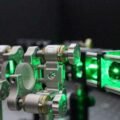Space travelers and off-world colonists may use mushrooms as radiation shields thanks to a special type of fungus known for its unique ability to absorb radiation. And based on recent experiments aboard the International Space Station, (ISS) this plant actually grew more robust, and at a faster pace, when it was blasted with the same radiation levels astronauts regularly experience.
BACKGROUND: THE RISKS OF RADIATION IN SPACE
According to The National Aeronautics and Space Administration, (NASA) humans in space experience significantly higher levels of radiation than when on Earth. This disparity is mainly due to the protective energy shield generated by the Earth’s magnetosphere that surrounds our planet, reflecting the bulk of the radiation emitted by the sun as well as other sources like cosmic rays back into space. This naturally occurring magnetic shield expands far enough above Earth’s surface to offer some protection to crews on the ISS, but it is no help to humans traveling beyond Earth orbit.
High levels of radiation exposure are also a critical issue for potential off-world colonists and space travelers who may choose to make the Moon or Mars their home one day, as both of those space bodies lack a magnetosphere.
“Over the period of one year, the average person on Earth is dosed with about 6.2 mSv, (millisieverts) while the average astronaut on the International Space Station (ISS) is exposed to an equivalent of approximately 144 mSv,” explains the research paper proposing mushrooms as radiation shields. “One year into a three-year mission to Mars, an astronaut would already have accumulated some 400 mSv.”
For comparison, this is about 10 percent of a lethal dose of radiation, and more than enough to threaten an astronaut’s overall health.
This challenge has led researchers to look at radiation suits, advanced material-based shielding, or even the idea of using the regolith (rocks and dirt) on Mars and the Moon to build huge radiation shelters. Thus far, none has been proven to be a catch-all solution.
ANALYSIS: RADIATION EATING MUSHROOMS SHOWN TO BE EFFECTIVE SHIELDS
Called Cladosporium sphaerospermum, the proposed mushroom is one that uses radiation as an energy source instead of sunlight. Known as radiosynthesis, that process is what makes the idea of growing mushrooms as radiation shields so tantalizing.
“These radiation-loving fungi survive on Earth in extreme places, like the site of the Chernobyl Nuclear Power Plant in Ukraine,” explains a piece by Universe Today. “In space, they do just as well.”
As proof of their potential for reducing human radiation exposure, researchers sent some of the radiation-chomping fungi to the ISS back in 2019. After 30 days, the team measured the amount of radiation that passed through the plant to determine its rate of absorption.
Sure enough, radiation levels beneath a 1.7 millimeter thick layer of fungus were 2.17% lower than underneath an unprotected control area. Even more encouraging, the fungus grew over 21% faster than it does on Earth. According to researchers, this is likely the result of the increased radiation levels aboard the ISS supercharging the plant to grow even faster than usual.
OUTLOOK: RADIATION SHIELDING FOR FUTURE SPACE TRAVELERS
Based on this level of efficacy, the research estimates that a habitat on Mars would likely need to be coated with a layer of radiation-eating fungi no smaller than 2.3 meters thick to be truly safe. For comparison, estimates show that a 3 meter thick shield made from Marian dirt would accomplish the same level of protection with much less work or resources. Still, the research paper notes, the concept of growing a radiation shield is particularly promising for long-duration space missions where Lunar or Martian regolith isn’t quite so handy.
For now, upcoming missions like NASA’s ARTEMIS will rely on traditional methods of shielding astronauts from the deadly power of solar flares or interstellar radiation. However, as humanity embarks on longer duration expeditions to the outer reaches of the solar system and beyond, as well as potentially putting down permanent communities on the Moon or Mars, it may turn out to be the fungus among us that saves humans from death by radiation.
Follow and connect with author Christopher Plain on Twitter: @plain_fiction
